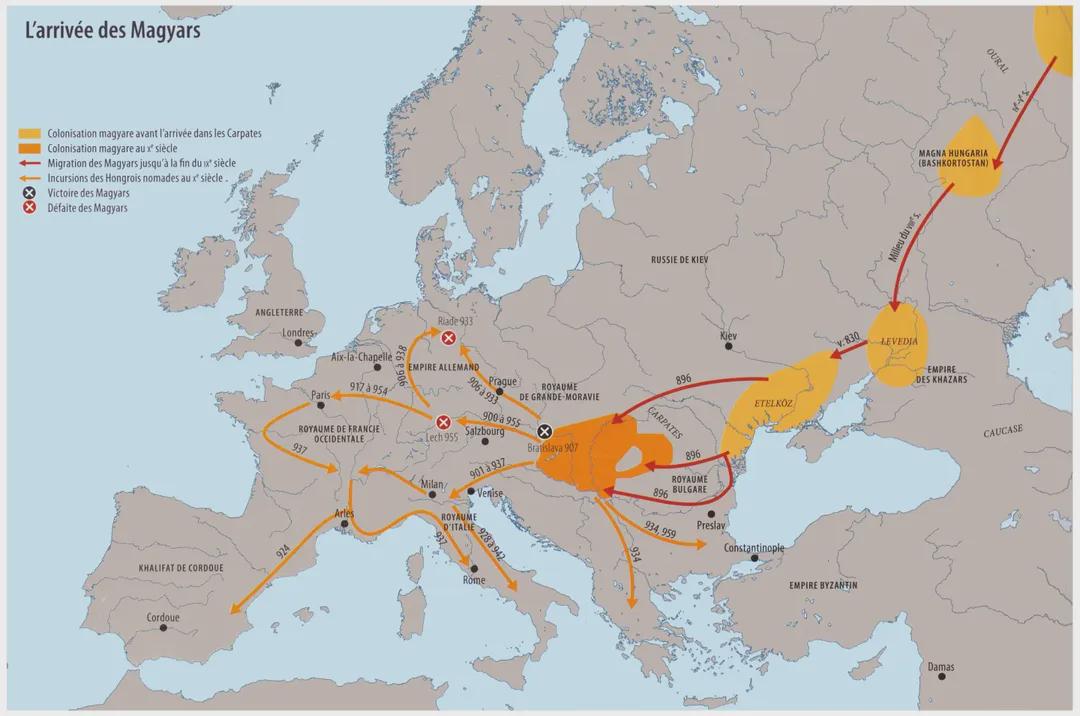Map of the Arrival of the Magyars in the 10th Century


Marcus Rodriguez
Historical Geography Expert
Marcus Rodriguez specializes in historical cartography and geographic data analysis. With a background in both history and geography, he brings unique...
Geographic Analysis
What This Map Shows
This map illustrates the arrival of the Magyars, also known as Hungarians, in the 10th century. It highlights the migration routes taken by these nomadic tribes as they traversed the Carpathian Basin, ultimately settling in what is now modern-day Hungary. The visualization provides key geographical contexts such as mountain ranges, rivers, and neighboring territories that played a crucial role in their movement. Understanding these routes offers insight into the historical dynamics of Central Europe during this transformative period.
Deep Dive into the Arrival of the Magyars
The Magyars emerged from the Ural Mountains and began their journey westward around the late 9th century. They were originally part of a larger group of Finno-Ugric tribes but differentiated themselves as they moved further into Europe. Their arrival in the Carpathian Basin around 895 AD marked a significant shift in the region's demographic and cultural landscape.
What’s fascinating is that the Magyars were not merely invaders; they were skilled horsemen and warriors, known for their unique military tactics and adaptability to different terrains. Their movement was largely influenced by the existing political structures, competing tribes, and the availability of resources. The map indicates various natural features, such as the Danube River, which served as both a barrier and a highway for their movement.
Interestingly, the Carpathian Mountains provided a natural fortress, allowing the Magyars to establish a stronghold in the basin. The rivers not only offered routes for travel but also fertile lands for agriculture, which became vital for their sustenance and growth. As they settled, they began to influence the local populations through trade, intermarriage, and cultural exchange, leading to the eventual establishment of the Kingdom of Hungary in the year 1000 AD under the rule of Stephen I.
The socio-political landscape of Europe was altered as the Magyars' presence contributed to the rise of feudalism in the region. Their unique blend of nomadic traditions and agricultural practices set the stage for Hungary's future development. They implemented a system of clans and tribes which played a crucial role in governance and local administration.
Regional Analysis
When examining the map closely, we can see how the Magyars interacted with neighboring tribes and nations. To the north, Slavic tribes had begun to settle, while to the south, the Byzantine Empire exerted influence over the Balkans. The competition for resources and territory led to numerous conflicts and alliances. For instance, the Magyars often clashed with the Germans and the Byzantines, who viewed their expansion as a threat.
Moreover, the eastern regions, where the Magyars originated, were characterized by a mix of diverse ethnic groups and languages, which contributed to a rich cultural exchange. The settlements established during the 10th century would influence the linguistic and cultural identity of the region for centuries to come.
In contrast, the western parts of the Carpathian Basin were more influenced by Roman and Germanic cultures, creating a cultural mosaic that is evident in Hungary's modern demographics. The impact of these initial movements can still be felt today, as Hungary remains a melting pot of various ethnic influences.
Significance and Impact
Understanding the arrival of the Magyars is crucial as it lays the groundwork for Hungary's historical narrative and its position in Europe. This migration not only shaped the demographics of the region but also had lasting implications on European cultural and political structures. The establishment of the Kingdom of Hungary became a pivotal moment, signifying the integration of the Magyars into European society.
Today, as we analyze current trends, it's essential to recognize how historical migrations continue to shape national identities and political landscapes. The Magyars' journey is a reminder of the fluidity of borders and cultures, reflecting ongoing discussions about migration and integration in Europe. The legacy of the Magyars serves as a lens through which we can understand contemporary issues related to ethnicity, nationalism, and cultural heritage.
In conclusion, the map of the arrival of the Magyars in the 10th century is not just a historical artifact; it is a testament to the complexity of human movement and cultural exchange that continues to resonate in modern Europe.
Visualization Details
- Published
- October 20, 2025
- Views
- 46
Comments
Loading comments...